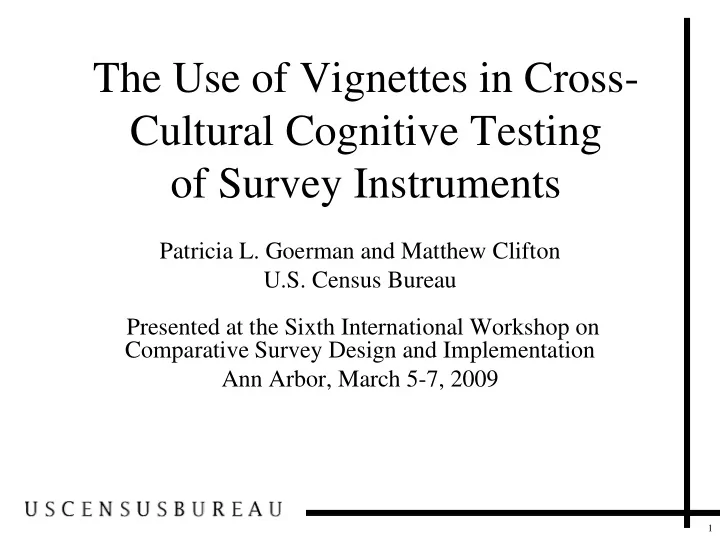

The Use of Vignettes in Cross- Cultural Cognitive Testing of Survey Instruments Patricia L. Goerman and Matthew Clifton U.S. Census Bureau Presented at the Sixth International Workshop on Comparative Survey Design and Implementation Ann Arbor, March 5-7, 2009 1
Goals of the Study • Add to “tool kit” of cognitive testing methods for bilingual or multilingual instruments • Examine the use of vignettes in cross- cultural research • Present experiences from two U.S. Census Bureau studies • Discuss areas for future research 2
Vignettes in Cognitive Testing • Definition: Brief stories or scenarios presented to respondents • Useful for testing sensitive or complex survey items • Useful for testing infrequently-asked survey questions where respondents with unusual characteristics would be ideal 3
Research Questions 1. Do vignettes need to be modified for use across language groups? 2. Are vignettes equally effective across groups? 3. Are vignettes a useful tool for testing survey translations? 4. How can they best be designed for use across languages? 4
Two Bilingual U.S. Census Bureau Studies 1. Pretesting of the first Spanish/English Bilingual questionnaire 2. Pretesting of the Spanish CATI/CAPI version of the American Community Survey (ACS) 5
1. Vignettes in the Bilingual Questionnaire project • Needed to test translation of specific relationship terms, for example: – Roomer or boarder • Difficulty of recruiting large number of respondents who lived with people of the desired categories 6
Bilingual questionnaire: Sample vignette 7
Bilingual questionnaire: Sample vignette, results • English speakers (25) : Roomer or boarder 14 answered correctly, 11 incorrectly 1 had difficulty with vignette Ed level: “some college” • Spanish/bilingual speakers (41): Inquilino/ pupilo 29 answered correctly, 12 incorrectly 7 had difficulty with vignette Ed level: from “less than HS” to “some college” 8
Bilingual questionnaire vignette Conclusions • Vignette worked well for most respondents • A number of Spanish speakers had difficulty • Variety of educational levels • Future projects: need to simplify vignettes to be sure that more respondents can understand as intended 9
2. Vignettes in the ACS project • Developed out of need to test “other living quarters” questions • Difficult to find respondents who fit complicated living situation in question • Resorted to vignettes to test questions 10
Example of “other living quarters” questions • Do you have direct access to [ADDRESS] from the outside or through a common hall? • Are there any other living quarters either occupied or vacant at [ADDRESS]? 11
ACS project, sample vignette text Imagine that you are renting a small apartment in the back of a house from a couple who also lives in the house. The address is 123 Main St. The couple lives in Apt. A and you live in Apt. B. You have your own private space: a large room that you use as a bedroom, a kitchen, and a bathroom. There is no door from your area to the outside. In order to go outside you have to walk through the couple’s living room. (See picture of floor plan A.) 12
Vignette image Drawing 1 APT. B APT. A 123 Main Street 13
ACS project, Sample vignette questions Do you have direct access to 123 Main Street, Apartment B either from the outside or through a common hall? “Correct” response: “No, neither.” Do you have to go through someone else’s living quarters to get to yours? “Correct” response: “Yes.” 14
Evaluating results: creation of behavior coding scheme • Respondents’ answers to vignette questions compared with answers to real-life “other living quarters” questions • Gauged effectiveness of vignettes in clarifying complex “other living quarters” question 15
Findings: Spanish speakers Do you have direct access to [ADDRESS] either from the outside or through a common hall? real-life question vignette question 10 answered correctly 13 answered incorrectly 3 still answered incorrectly 5 more answered in real life correctly but answered the vignette incorrectly “success” rates: 33 answered correctly 38 answered the vignette correctly (71.7%) (82.6%) 13 answered incorrectly 8 answered the vignette incorrectly (28.3%) (17.4%) 16
Findings: English speakers Do you have direct access to [ADDRESS] either from the outside or through a common hall? real-life question vignette question 3 answered incorrectly 3 answered correctly 2 answered correctly for real life situation but got the vignette wrong “success rates” 8 answered correctly 9 answered correctly (72.8%) (82%) 3 answered incorrectly 2 answered incorrectly (27.2%) (18%) 17
Trends based on educational level Real life v. vignette questions • No clear trend by educational level • Majority of respondents, regardless of ed level, answered both real-life and the vignette questions correctly • No English-speaking Rs answered both real life and vignette questions incorrectly • Only 3 Spanish speakers did so (2 HS, 1 College). 18
ACS Project vignette Conclusions • On the whole vignettes were successful in helping to study potentially confusing questions • Text with picture approach worked equally well both for English and Spanish speakers, and for both high and low educational level respondents 19
Potential Problems • Rs more likely to provide correct answer after seeing vignette than in their own real- life situation • Question makes more sense when living in exact situation survey designers have in mind • Rs will make questions “fit” their situation 20
Areas for Future Research • Situations where vignettes don’t translate well across cultures • How to develop different vignettes that will elicit the same information across cultures • Should vignettes undergo “pretesting” process to be sure they will work across languages? • Other administration modes: e.g. “Visual vignettes” (Carter, 2008) 21
For more information: E-mail: Patricia.L.Goerman@census.gov 22
Recommend
More recommend